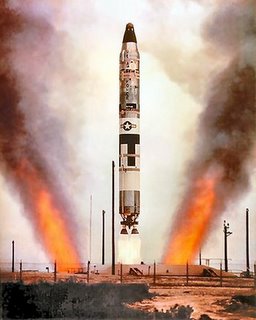Instead of Launching on Warning…


The public considers nuclear weapons an obsolete issue. The world survived it in the 1980s and can now forget about it. Supposedly, what we confront now instead is the problem of “Weapons of Mass Destruction ,” and even those WMDs are no longer high on the global agenda, since we have learned that Saddam Hussein didn’t have any. According to this theory, we can just cross nuclear weapons off our list of worries, unless something unexpected happens.
If you believe this, I’ve got news for you. “WMDs” include nuclear weapons. Indeed, they are still the most dangerous kind of WMD. Moreover, some 27,000 of them still exist on the planet, many of which are on “launch on warning ” status. We should be as worried as ever about them, and they still belong among our top priorities.
Nuclear weapons exist for only one purpose: deterrence. And, if I may revive the terminology of the Cold War, nuclear deterrence is a policy of MAD: “Mutual Assured Destruction.” Let me explain. Suppose we have two sides in a conflict, both of them armed with nuclear-armed missiles and both fearing that the other side might attack them. They both realize that they must convince their opponent that, if they do launch, they too will certainly be destroyed.
To make this threat convincing, both sides have concluded that they cannot afford to wait for missiles to land on their own territory before retaliating. Delay may result in the destruction of one’s own missiles before they can get off the ground. Both sides need to retaliate before the incoming missiles hit. This requires launching as soon as it is known that incoming missiles are on the way. To do so is to “launch-on-warning.”
The problem with “launch-on-warning” is that sometimes the warning is only a false alarm. In fact, that happens quite often. There’s less than half-an-hour in which to re-check the alarm and discuss what to do. Within 30 minutes the incoming missiles will land and civilization will end. Fortunately, whenever there has been enough time to re-check, the warning has always turned out to be a false alarm that could safely be ignored.
However, on several occasions the warning has not been disconfirmed during the available time frame and, had the prescribed operating procedures been followed, you and I would be dead. For example, in 1983 the commander of a Soviet nuclear missile bunker Colonel Stanislav Petrov, refused to obey orders, even though the radar detected a group of incoming American missiles.(See his photo, and also see http://www.peacemagazine.org/archive/v17n2p16.htm) He saved the lives of many millions of human beings. Yet,nuclear weapons experts all agree that unless this dangerous system of launch on warning is abandoned, our luck will run out some day. Eventually, a false alarm will trigger Armageddon, for not everyone is as courageous and independent as Colonel Petrov.
So what can be done to prevent this mistake?
Certainly the best solution is complete nuclear disarmament. However, the Bush Administration is not willing to abolish their nuclear weapons, nor have other previous US administrations done so. They believe somehow that mutual deterrence is still necessary. I believe, on the contrary, that nuclear weapons are a terrible scourge for the world. Nevertheless, until we can persuade powerful decision-makers, we need a Plan B: something that will reduce the dangers of launch-on-warning, without actually eliminating mutual deterrence. I know of one such solution, proposed by Dr. Alan Phillips and Mr. Steve Starr. They call it RLOAD — “Retaliatory Launch Only After Detonation.”
By no means does RLOAD completely eliminate the prospect of a nuclear war. In fact, it only eliminates one of many possible ways in which a nuclear tragedy might take place. Fortunately, however, that one way is the most dangerous of all and it can be addressed and resolved immediately. The only change consists of this new policy: Instead of launching a retaliatory strike as soon as a credible warning has been received, the president of a country will launch that retaliatory strike only if a nuclear detonation is reported at a place and time consistent with the plotted trajectories. All preparations are made at the silos to launch instantly without further orders when notification of a detonation is received. The order is automatically voided if no detonation is detected by a certain stated time.
Compare the outcome of the two options, launch-on-warning and RLOAD. In the case of launch-on-warning, war starts, regardless of whether the incoming attack was real or a false alarm. In the case of RLOAD, war starts if the attack is real. But there is still peace if the presumed attack was a false warning.
The United States and Russia are, to this day, the owners of the greatest nuclear arsenals. I wish they would disarm, but there is no foreseeable prospect that they will do so. The other nuclear powers possess weapons capable of causing devastation in a few places on earth, but humankind as a whole would survive their nuclear exchanges. None of us would survive a nuclear war between the United States and Russia. Above all else, we must keep that from happening. It is most likely to happen by mistake, rather than intentionally. The mistake would arise from one of the false alarms that frequently take place. RLOAD, if adopted as a policy by both Russia and the United States, would prevent nuclear wars started as the response to a false alarm. That is all it would do. It’s not the solution to all our problems. Nevertheless, it is an enormously valuable suggestion that could be adopted by even the most hawkish military leaders who want to keep their nuclear deterrent. I vote for RLOAD.



0 Comments:
Post a Comment
<< Home